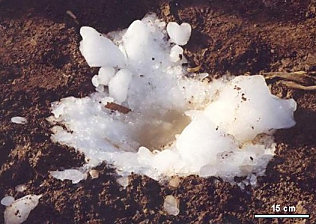© 2006 All Rights Reserved. Do not distribute or repurpose this work without written permission from the copyright holder(s).
Printed from https://danginteresting.com/the-peculiar-phenomenon-of-megacryometeors/

Hail, in and of itself, is not an unusual weather phenomenon. The frozen precipitation occurs inside storm clouds when water droplets are cooled below freezing, yet remain in a liquid state. When the supercooled water encounters something solid, such as a speck of dust or an ice crystal, it sticks to the particle and freezes. Updrafts in the storm keep the hailstone aloft as it aggregates ice, growing until its weight is too heavy for the updraft, at which time it plunges to the Earth.
Some scientists believe that there is a larger, more sinister type of ice-chunk precipitation which can form outside of storms, making even the largest hailstones look puny in comparison. There is a great deal of disagreement in the scientific community regarding the origin of these falling slabs of ice, but it is certain that something is causing massive frozen chunks to occasionally drop from seemingly empty skies. The objects are called megacryometeors.
The term was coined by researcher Jesús Martínez-Frías, a planetary geologist from Madrid, Spain. In the year 2000, he investigated a series of such mystery ice meteors which began with a four-and-a-half pound object that smashed through the windshield of parked car in the city of Tocina. It fell out of a clear, sunny sky in January. Soon there were reports of similar incidents in the surrounding area, which continued at irregular intervals for about a week before they stopped as mysteriously as they had started.
Over the past decade, over fifty such objects have been recorded worldwide. Some have been as small as about one pound, but one monstrous mass of ice that fell in Brazil weighed about 400 pounds— almost a quarter of a ton— and crashed through the roof of a Mercedes-Benz factory. One recently made headlines in Oakland, California, weighing over 200 pounds and creating a dent in the Earth three feet deep. A similar event occurred in Chicago last February, crashing through the roof of a house.
Martínez-Frías led the research on the objects in Spain, examining the ice and impact sites from multiple megacryometeors. The ice was found to be free of urine, feces, and disinfecting solutions, so it was determined that its source was not an airplane’s frozen waste water. In fact, at the times of several of the events, the official records of air traffic control showed no airplanes in the skies over the areas in question. The makeup of the ice was vastly different from that of comets, so an extraterrestrial original was ruled out. But the composition of the frozen water did bear a very striking resemblance to that of a well-known weather phenomenon: hail.

The mysterious ice blobs, like hail, have been found to contain air bubbles, onion-like layering, and traces of ammonia and silica. The icy objects also have isotopic distributions of oxygen-18 and deuterium similar to those found in hailstones. Aside from their surprising mass and their tendency to plunge one-at-a-time from clear skies, the ice balls are almost identical to hail. Adding further intrigue to the investigation, it was discovered that there were several peculiar conditions in the high atmosphere over Spain that day: ozone levels were lower than normal, causing the troposphere to be particularly warm and the stratosphere to be particularly cold… also, the lower stratosphere was more humid than usual, and there was strong wind shear in the upper atmosphere.
Martínez-Frías and his team speculate that these meteorological ingredients may have worked together to create a situation where ice balls formed high in the atmosphere, aggregating ice as they descended until they grew to enormous size. They believe that the recent increase in the frequency of these megacryometeors worldwide may be due to the effects of global warming.
Many scientists are skeptical of the notion that these ice chunks are atmospheric conglomerations. Their most likely source, according to some, is passing aircraft. It may be that rainwater collects on the fuselage of aircraft, freezes during flight, and then becomes dislodged and falls to the Earth. Although Martínez-Frías was unable to find evidence of passing aircraft during the times of several events, it is possible that the flight-control records do not include all military and private aircraft.

Another possible explanation is that Martínez-Frías and his team have been duped by an elaborate hoax, but that seems unlikely given the numerous megacryometeor events which have occurred worldwide over a span of many years. Consider also Brazil’s 400-pound behemoth… such an ice ball would be exceedingly difficult to create and deliver without spending a great deal of money and drawing some attention. Another factor ruling out a hoax is that such ice-meteor events have been recorded (though with much less frequency) since times before aircraft were invented.
Whether or not you subscribe to the idea that humankind can have such a serious impact on our planet’s weather systems, it is certain that the hail-from-h#ll theory is worth investigating. Regardless of the cause, it is vaguely alarming to consider that on occasion, very large chunks of ice can fall out of a clear blue sky without explanation. Even more troubling, it seems to be happening more and more.
© 2006 All Rights Reserved. Do not distribute or repurpose this work without written permission from the copyright holder(s).
Printed from https://danginteresting.com/the-peculiar-phenomenon-of-megacryometeors/
Since you enjoyed our work enough to print it out, and read it clear to the end, would you consider donating a few dollars at https://danginteresting.com/donate ?